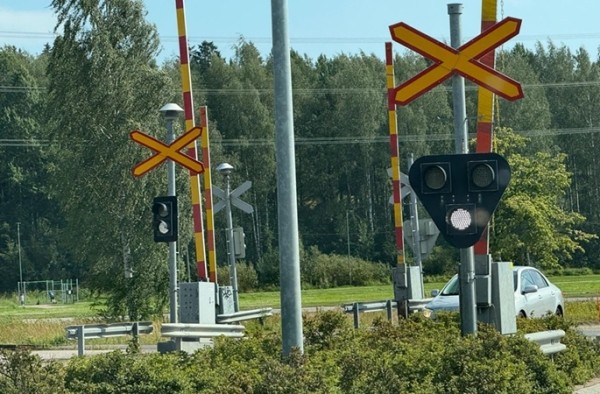
Frequent accidents on the level crossings early this month have raised questions about the safe vehicular movement through the crossings in Finland.
Pointing out some factors as main reasons for the accidents, the authorities are also planning to remove some unguarded level crossings where conditions do not allow safe crossing.
Three people died and several were injured in three accidents on the level crossing in Finland in one week in August 3–8.
According to the Finnish Transport and Communication Agency (Traficom), the authorities marked more than 500 level crossings for removal or upgrade in the coming years.
Experts said that sight obstruction, narrow crossing angles, errors in evaluation by vehicle users, lack of warning systems and other human-related risks are the main reasons for the accidents on the level crossing.
“Sight obstruction caused by the environment such as trees and bushes was among the main factors impairing driver’s ability to see trains,” Anne Silla, Traficom chief adviser on railway safety has told the Daily Finland.
She also said that in many cases, the crossing angle was too narrow, forcing drivers to look over their shoulder to detect a train approaching.
“On some level crossings, the designated waiting area was entirely missing, reducing the likelihood that drivers would stop and further obstructing their view,” she explained.
She also noted that familiarity with the surroundings also appears to be causing complacency among some motorists approaching low-traffic crossings assuming that no train is coming.
“In some cases, the driver’s impaired health or sensory capacity such as reduced hearing or vision due to factors like medical conditions or alcohol consumption may also have hindered observation ability,” she added.
The other immediate risk factors identified include anticipation or evaluation errors by road users, vehicle handling mistakes and other human-related risks such as deliberately entering the crossing despite the danger, the Traficom adviser said.
The Finnish Transport Infrastructure Agency (FTIA), meanwhile, said that malfunctioning barriers or signals do not play a role in any of the recorded accidents in the past.
“Typically, accidents occur in daylight and in good weather,” Tomi Kangas, Director of Safety and Security of the FTIA told the Daily Finland.
According to the FTIA, the railway network has 2,370 level crossings, of which 1,647 (around 69 percent) lack any warning systems such as barriers or audio-visual alarms.
The authorities launched the national level crossing improvement programme in 2017 and continue to remove or upgrade level crossings under various projects and during routine railway maintenance.
This year’s programme objectives include the removal of around 40 level crossings, the installation of warning systems at roughly 10 sites, the implementation of measures on about five crossings and the renewal of about 10 systems that have reached the end of their operational life.
In reply to a query regarding unguarded level crossings, Kangas said that high costs of major safety upgrades is the main barrier to establishing guard systems on the crossings.
“The cost for the installation of half-barriers at a single crossing can range from €300,000 to €450,000 while replacement with a bridge or underpass can cost several million euros,” he said.
The FTIA is also implementing lower-cost safety enhancement measures.
The measures include improving visibility at crossings, upgrading waiting areas on roads, installing mandatory stop signs, reducing road or railway speed limits and adding warning lights.
In a move to reduce accident risks, the FTIA in June 2024 launched a three-year campaign to create awareness, promoting level crossing safety.
Most level crossings in Finland are located on low-traffic private roads, forest roads and field roads. Traffic on such roads may be very light or seasonal. Dozens of them are removed each year.
Anni Romu, the head of media relations of the national railway operator VR Group, said that dealing with potentially dangerous level crossing collisions has already become part of the basic training for VR train drivers and risk scenarios are also practised using simulators.
“Railway traffic must always be taken seriously. A train cannot swerve and it requires a much longer distance to stop compared with a car. On level crossings, the car driver is always obliged to yield,” she told the Daily Finland.
Finland has recorded four fatalities, one serious injury and three minor ones from a total of eight level crossing accidents in January–13 August 2025. Five of the incidents occurred at unguarded crossings.
The authorities, however, said that in 2024, there were 11 level crossing accidents reported, the lowest ever number recorded since monitoring began in the Nordic country more than 70 years ago. No human casualty was reported in 2024.
Ninety-one per cent of the accidents took place at unguarded crossings.
Until 2021, Finland averaged 29 level crossing accidents a year. The number began to decline in 2022, with 15 accidents recorded that year and 14 in 2023.
Source: www.dailyfinland.fi


